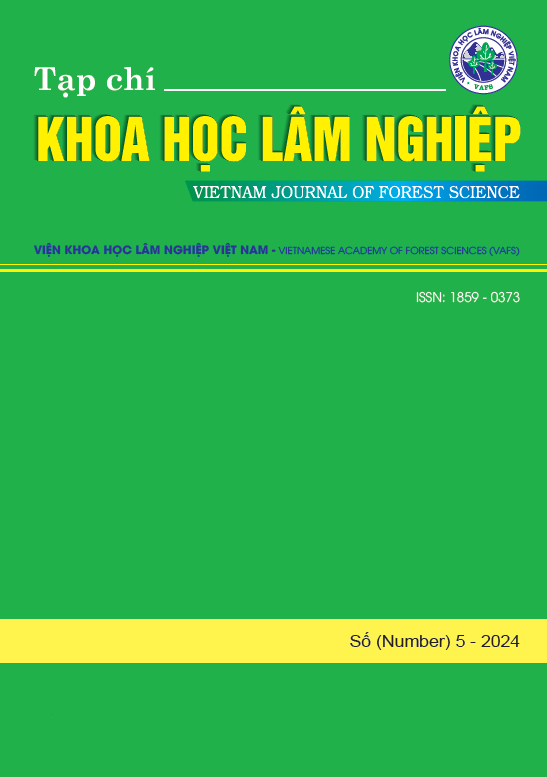HIỆU QUẢ KINH TẾ CHUỖI GIÁ TRỊ VÁN BÓC TẠI TỈNH YÊN BÁI
DOI:
https://doi.org/10.70169/VJFS.944Keywords:
Economic efficiency, Value chain, Peeled veneer, Yen Bai provinceAbstract
The study on the economic efficiency of the peeled veneer value chain in Yen Bai province was conducted with 96 afforestation households, 01 forestry company, 05 timber traders, 09 peeled veneer processing facilities and a number of local managers. The survey results show that to produce 1m3 of peeled veneer, the average output of raw wood is from 1.55 to 1.65 m3 of wood with a minimum diameter of 10cm. Net profit (NPr) of the whole chain reached from 538,437 VND to 812,853 VND; in which, the profit of the processing stage was the highest, reaching from 173,513 VND to 317,369 VND, accounting for the proportion from 31.78% to 34.52% and the stage with the lowest profit was the trading stage of peeled veneer from 13.93% to 14.15% of the whole chain. The added value (VA) of the whole chain reached from 1,391,288 VND to 1,753,432 VND; in which, VA in the stage of timber harvesting and processing of peeled veneer is the highest, reaching from 521,125 VND to 777,769 VND, accounting for from 35.77% to 44.36%. The lowest VA is the stage of planting forests to create raw materials from 150,843 VND to 163,470 VND, accounting for 9.32% to 10.84% of the whole chain. In the peeled veneer value chain, the processing of peeled veneer is the most important stage and has the greatest valuable contribution to economic efficiency in the whole chain. In order to improve the economic efficiency of the peeled veneer value chain, the stages in the chain need to invest in selecting good input materials for production, increasing the proportion of using quality labor resources, applying advanced processes, technologies and modern machinery and equipment to improve the efficiency of using production resources, increasing the rate of using wood in processing, improving the quality of output products to best meet the requirements of customers, thereby ensuring appropriate selling prices and benefits in accordance with production capacity. In particular, the formation of horizontal links and along value chain to ensure timber legality and easily implement traceability throughout the entire supply chain aiming sustainability for production.
References
Thủ tướng chính phủ (2021): Quyết định số 523/QĐ-TTg ngày 01/4/2021 phê duyệt Chiến lược phát triển lâm nghiệp Việt Nam giai đoạn 2021-2030, tầm nhìn đến năm 2050.
Thủ tướng Chính phủ (2022): Quyết định 327/QĐ-TTg ngày 10/3/2022 Phê duyệt Đề án phát triển ngành công nghiệp chế biến gỗ bền vững, hiệu quả giai đoạn 2021 - 2030.
Công ty TNHH MTV Lâm Nghiệp Ngòi Lao (2021): Hồ sơ thiết kế, dự toán trồng, chăm sóc và bảo vệ rừng năm 2022.
Chi cục Kiểm Lâm tỉnh Yên Bái (2022): Biểu thống kê các cơ sở chế biến, kinh doanh gỗ - kết quả sản xuất, kinh doanh toàn tỉnh Yên Bái đến tháng 4 năm 2022









